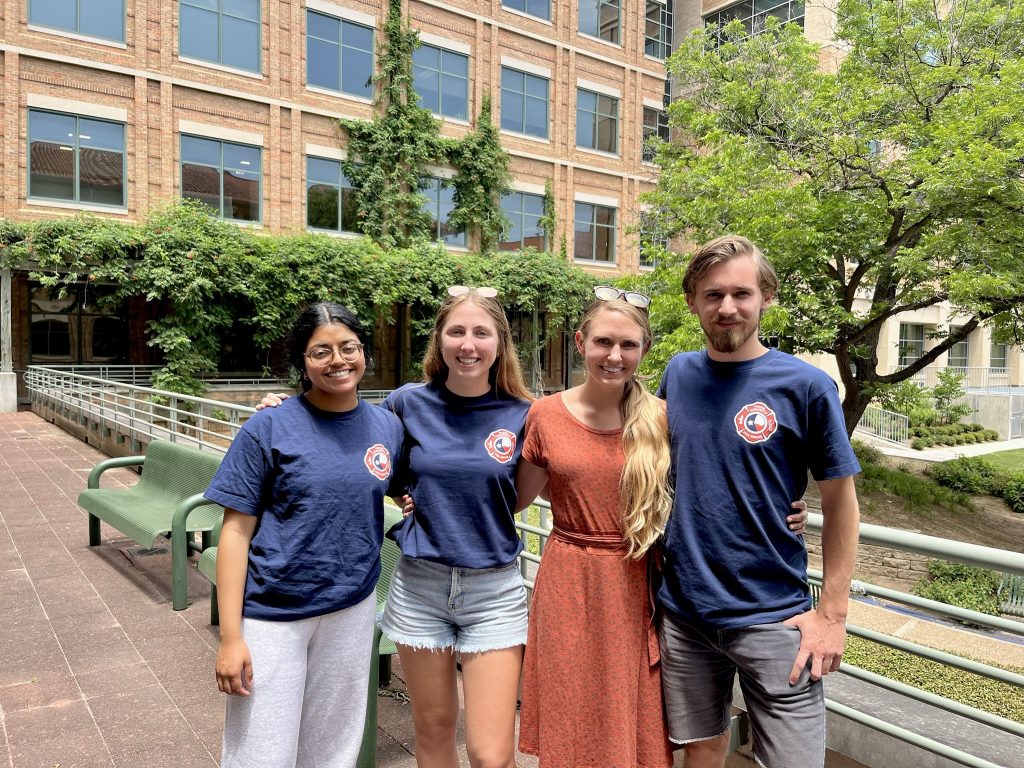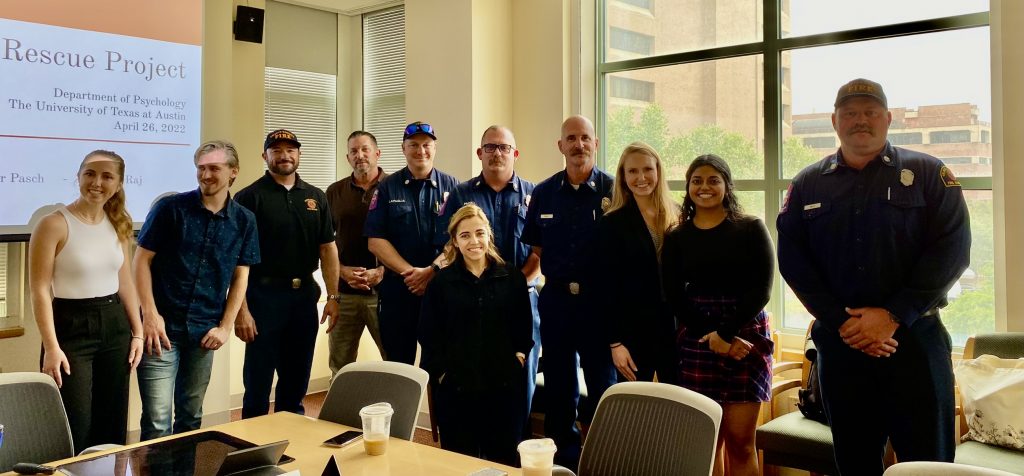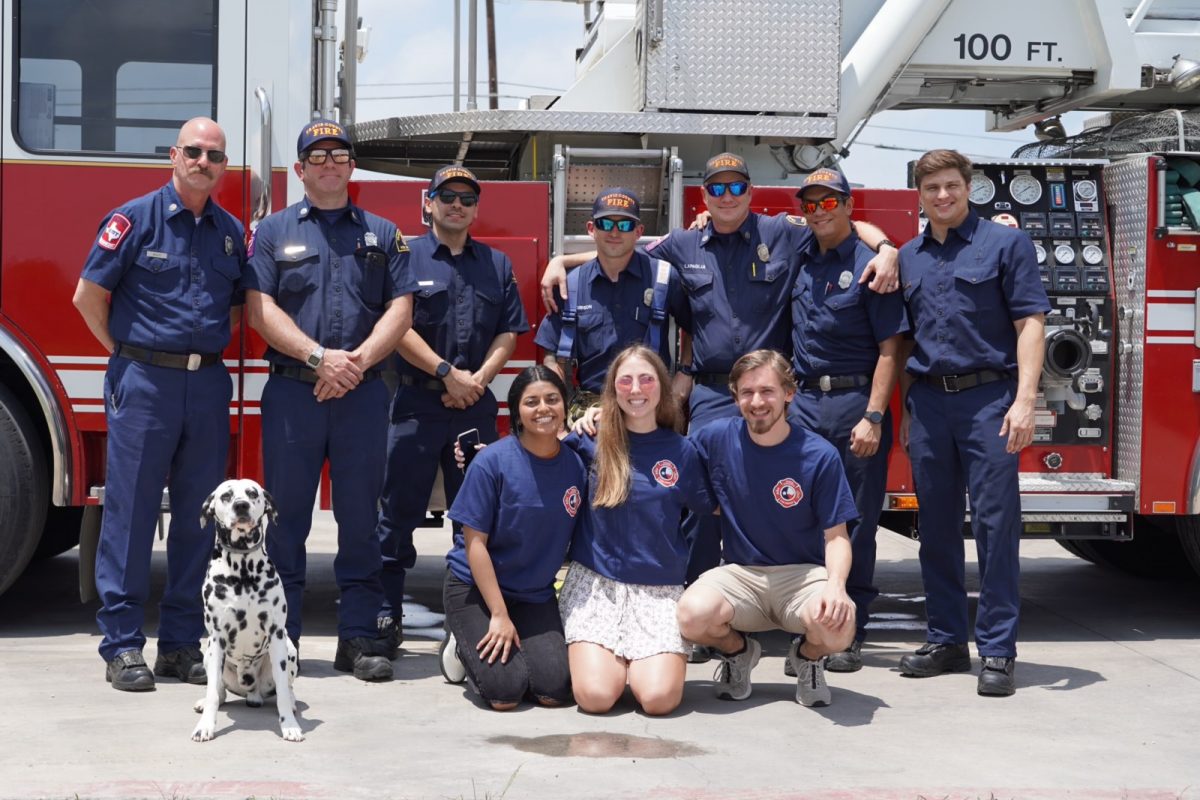When Chief Ken Bailey, head of Travis County Fire Rescue ESD No. 11, realized his organization had a problem with staff morale and turnover, he turned to an unlikely place for help: UT Austin’s Applied Psychology Research Lab, led by assistant research professor Alissa Mrazek.
Bailey’s district serves a wedge of Travis County that stretches south and east of Austin and covers areas including Creedmoor and Del Valle. Its firefighters answer around 8,000 emergency response calls a year, and the district has one of the highest percentages of high-acuity calls in the county. The district prides itself on serving its community, but a couple of years ago, staff morale began to dip precipitously. The firefighters were burned out and less engaged; many began talking about leaving for other districts, and some followed through.
Bailey read the signs and quickly recognized the need for change, but he wasn’t quite sure where to begin. He first turned to an HR contractor, but after a single session talking with a sample of the district’s staff, the contractor offered only vague recommendations to “communicate better” and “offer staff encouragement.” Meanwhile, firefighters continued to leave the district in search of better pay and less demanding positions.
“It made me realize that maybe I wasn’t identifying with these people, maybe I’m missing the boat,” Bailey said. “So, I started to dig into what builds a culture, what grows a culture, and one of the big questions I had was what motivates people in an organization and what demotivates them. But I’m not a psychologist, and I knew that we needed some guidance here.”
That need for guidance prompted Bailey to make an unusual move: He wrote a letter to David Schnyer, chair of UT Austin’s psychology department, asking for help. Schnyer thought immediately of Mrazek and made the connection. What started as a cold call began to become a partnership.
Bailey’s ask for Mrazek and her team was straightforward: Could the psychologists help the fire district to improve organizational commitment and wellbeing among its firefighters?
“It felt a bit out of my wheelhouse because I’d never worked with first responders before,” Mrazek said. But she was used to working with institutions to find evidence-supported ways to increase individuals’ well-being, and Bailey’s ask fell well within that skillset. Mrazek’s research interests include developing interventions to support high school students’ mental health, and she could see the overlap between working with schools and working with the fire district.
With the help of her research assistants Bailey Dow, Alexander Pasch and Aneka Raj, Mrazek began to learn all she could about the typical problems facing first responders and about the specifics of the fire district. After spending the fall semester researching, planning, and talking with Bailey to learn more about his concerns, the team launched the heart of their project: an extensive series of hour-long focus groups that would eventually include every firefighter and lieutenant in the district.

“The focus groups were kept small, like five people or less, which was time consuming but also meant that we heard in depth from every single person in the organization,” Mrazek explained. The groups were also conducted with an eye to the inherently hierarchical nature of fire crews: “One important thing was that the lieutenants were never in the focus groups with the firefighters, so no one ever had to talk about culture in front of their boss.”
In all, Mrazek and her team of research assistants conducted 14 hour-long focus groups. They were careful to make sure that each member of the district answered every question asked, and they started with the newest hires first to prevent the group from deferring to those with the highest seniority.
“The focus group gave an opportunity for everyone to be heard,” says Hunter Kennedy, an employee with the district who participated in the groups. “This developed a consensus that the newest to the most experienced person had a meaningful say in where the organization will head in the future.”
After completing the groups, Mrazek and her team transcribed each conversation before reviewing and sorting the responses to identify common themes.
The analysis of the focus group transcripts was done using a research practice known as inductive coding, in which researchers tackle raw data without any preconceived themes and instead generate themes in response to the data itself.
“We had all four members of our team do the coding individually, coming up with the themes that they felt fit best, which is a practice in inductive coding to avoid reading your own biases into it,” Mrazek said. “Then we came together and tried to identify where we overlapped.”
Though they agreed quickly on some themes, the researchers disagreed on nuances of others. In those cases, they’d return to the raw data together, discuss the context of the comments in question, and together decide how to phrase the theme. All told, the researchers identified more than 130 themes in the firefighters’ and lieutenants’ focus group responses.
Each of Mrazek’s research assistants then reviewed the full transcripts again, this time marking whether or not each firefighter mentioned each theme. The result was three full data sets, one from each assistant, that could be analyzed individually and as a group. Mrazek ran reliability analyses across the datasets to assess their level of agreement — a dataset that showed a very different interpretation of the themes could have skewed the study’s final results — and then counted how many firefighters mentioned each individual theme. From there, the researchers were able to identify the most common concerns shared by the fire district’s staff.
Armed with the themes and their frequencies, the researchers scheduled an April meeting with Bailey and his leadership team. It was time to give their report.

“He got the full debriefing of every single theme,” said Mrazek. “He just cares so much about the organization that he wanted every single theme, no matter how small.”
“The end product gave us a sense of weight,” Bailey said. “They were able to tell us, ‘Here are the things that are really important to a lot of people, and then here are the things that are really important to only a few people,’ and everything in between.”
The final themes covered a wide range of issues. The firefighters talked about having a lack of trust in each other and in their organization and about feeling like the district and its leadership struggled to communicate organizational changes effectively. But they also talked about finding meaning in camaraderie and community, and about their love of friendly competition.
Armed with those themes and frequencies, Mrazek and Bailey began to collaborate on finding solutions that could address firefighters’ concerns and build a strong organizational culture in the district. These included implementing individual and crew skill assessments, the results of which were public across the district. The assessments played on the firefighters’ love of competition while also, by highlighting the positive results of the assessments, demonstrating how capable their crew mates are. This in turn built trust, something essential to working together in life-threatening situations.
At the same time, the district began intentionally creating opportunities outside of work for crews to get together and bring their families. “That really builds this community and brings a higher level of engagement,” Bailey said. He and his team have also worked to give firefighters and lieutenants a greater sense of agency and autonomy, to improve their communications, and to give the district’s young crew members more recognition and validation for their accomplishments.
“That was a struggle for me personally, because I feel like we provide a service to a community, and that service is about them, the people across the street from the fire station rather than the people in the fire station,” Bailey said. “But what UT brought to me was that I’m in a different part of life than many of our firefighters, and it’s my job to find out about them and how to support them.”
“You have a lot of moving parts in any organization that’s larger than two people, and it’s entirely about attitude,” Bailey continued. “It’s about value, purpose, and meaning, at the individual level and collectively. And we are not adequately trained to understand that, or even organizationally positioned to do that, so having the help of these UT Austin psychologists that are able to give us clarity and direction on those goals has been huge. The work that UT did gave us some light in this room that was just filled with darkness, and now we have a purposeful sense of direction.”
Several months after implementing its responses to Mrazek’s findings, the fire district sent an anonymous survey to its staff to gauge what, if any, improvements in morale had resulted from the changes. The results were extremely positive: 90-plus percent of employees reported feeling pleased with overall district leadership, with the culture of the district, and with the district’s communications. The staff also reported feeling “good” or “excellent” about their opportunities for development and advancement as well as the district’s overall expectations and standards. In less than a year, morale had shifted dramatically for the better.
Bailey is encouraged by the progress already being made across the fire district, and he and Mrazek have left the door open to another round of focus groups next year to see how impactful the organizational changes have been.
While many details about future collaborations have yet to be worked out, Mrazek says her work with the district and its firefighters has been extremely meaningful. “I love when we can use science to make the world better,” she said. “There’s a lot of science that’s rigorous and has the potential for application, but then it doesn’t end up going anywhere. For me personally, the applied side of this research is so satisfying, and I love to have that synergy between people with different skill sets. Chief Bailey knows a lot about how to put out fires, but he doesn’t know about inductive coding. Together, though, we’ve really been able to make a difference here.”
